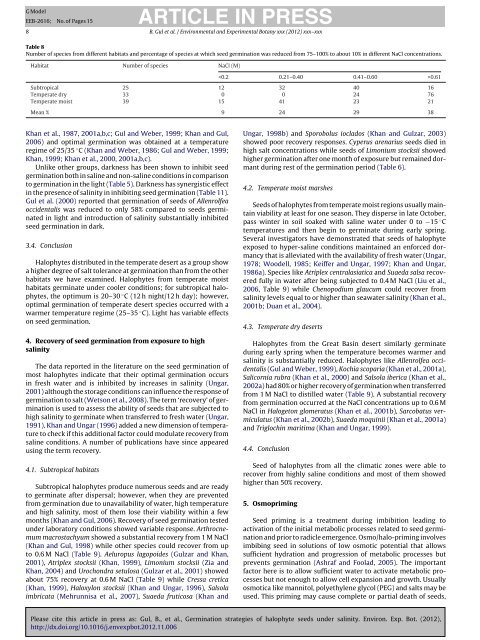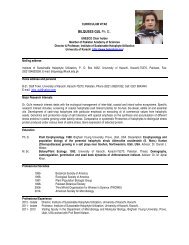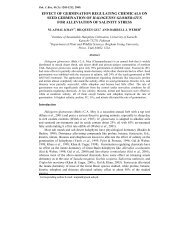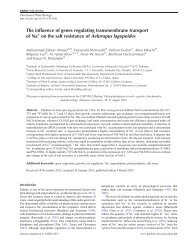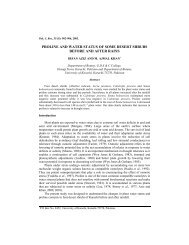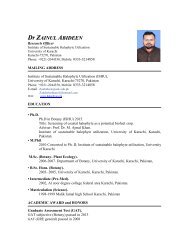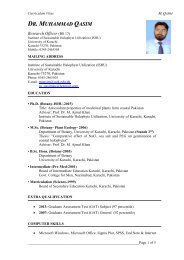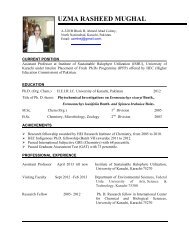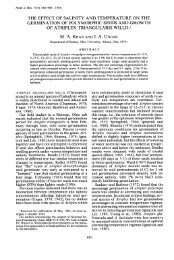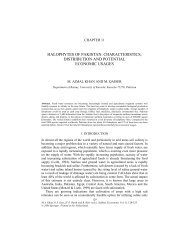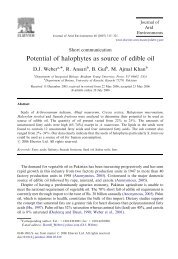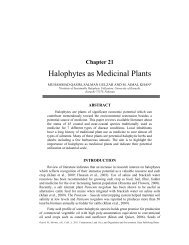Germination strategies of halophyte seeds under ... - ResearchGate
Germination strategies of halophyte seeds under ... - ResearchGate
Germination strategies of halophyte seeds under ... - ResearchGate
You also want an ePaper? Increase the reach of your titles
YUMPU automatically turns print PDFs into web optimized ePapers that Google loves.
ARTICLE IN PRESS<br />
G Model<br />
EEB-2616; No. <strong>of</strong> Pages 15<br />
8 B. Gul et al. / Environmental and Experimental Botany xxx (2012) xxx–xxx<br />
Table 8<br />
Number <strong>of</strong> species from different habitats and percentage <strong>of</strong> species at which seed germination was reduced from 75–100% to about 10% in different NaCl concentrations.<br />
Habitat Number <strong>of</strong> species NaCl (M)<br />
0.61<br />
Subtropical 25 12 32 40 16<br />
Temperate dry 33 0 0 24 76<br />
Temperate moist 39 15 41 23 21<br />
Mean % 9 24 29 38<br />
Khan et al., 1987, 2001a,b,c; Gul and Weber, 1999; Khan and Gul,<br />
2006) and optimal germination was obtained at a temperature<br />
regime <strong>of</strong> 25/35 ◦ C (Khan and Weber, 1986; Gul and Weber, 1999;<br />
Khan, 1999; Khan et al., 2000, 2001a,b,c).<br />
Unlike other groups, darkness has been shown to inhibit seed<br />
germination both in saline and non-saline conditions in comparison<br />
to germination in the light (Table 5). Darkness has synergistic effect<br />
in the presence <strong>of</strong> salinity in inhibiting seed germination (Table 11).<br />
Gul et al. (2000) reported that germination <strong>of</strong> <strong>seeds</strong> <strong>of</strong> Allenrolfea<br />
occidentalis was reduced to only 58% compared to <strong>seeds</strong> germinated<br />
in light and introduction <strong>of</strong> salinity substantially inhibited<br />
seed germination in dark.<br />
3.4. Conclusion<br />
Halophytes distributed in the temperate desert as a group show<br />
a higher degree <strong>of</strong> salt tolerance at germination than from the other<br />
habitats we have examined. Halophytes from temperate moist<br />
habitats germinate <strong>under</strong> cooler conditions; for subtropical <strong>halophyte</strong>s,<br />
the optimum is 20–30 ◦ C (12 h night/12 h day); however,<br />
optimal germination <strong>of</strong> temperate desert species occurred with a<br />
warmer temperature regime (25–35 ◦ C). Light has variable effects<br />
on seed germination.<br />
4. Recovery <strong>of</strong> seed germination from exposure to high<br />
salinity<br />
The data reported in the literature on the seed germination <strong>of</strong><br />
most <strong>halophyte</strong>s indicate that their optimal germination occurs<br />
in fresh water and is inhibited by increases in salinity (Ungar,<br />
2001) although the storage conditions can influence the response <strong>of</strong><br />
germination to salt (Wetson et al., 2008). The term ‘recovery’ <strong>of</strong> germination<br />
is used to assess the ability <strong>of</strong> <strong>seeds</strong> that are subjected to<br />
high salinity to germinate when transferred to fresh water (Ungar,<br />
1991). Khan and Ungar (1996) added a new dimension <strong>of</strong> temperature<br />
to check if this additional factor could modulate recovery from<br />
saline conditions. A number <strong>of</strong> publications have since appeared<br />
using the term recovery.<br />
4.1. Subtropical habitats<br />
Subtropical <strong>halophyte</strong>s produce numerous <strong>seeds</strong> and are ready<br />
to germinate after dispersal; however, when they are prevented<br />
from germination due to unavailability <strong>of</strong> water, high temperature<br />
and high salinity, most <strong>of</strong> them lose their viability within a few<br />
months (Khan and Gul, 2006). Recovery <strong>of</strong> seed germination tested<br />
<strong>under</strong> laboratory conditions showed variable response. Arthrocnemum<br />
macrostachyum showed a substantial recovery from 1 M NaCl<br />
(Khan and Gul, 1998) while other species could recover from up<br />
to 0.6 M NaCl (Table 9). Aeluropus lagopoides (Gulzar and Khan,<br />
2001), Atriplex stocksii (Khan, 1999), Limonium stocksii (Zia and<br />
Khan, 2004) and Urochondra setulosa (Gulzar et al., 2001) showed<br />
about 75% recovery at 0.6 M NaCl (Table 9) while Cressa cretica<br />
(Khan, 1999), Haloxylon stocksii (Khan and Ungar, 1996), Salsola<br />
imbricata (Mehrunnisa et al., 2007), Suaeda fruticosa (Khan and<br />
Ungar, 1998b) and Sporobolus ioclados (Khan and Gulzar, 2003)<br />
showed poor recovery responses. Cyperus arenarius <strong>seeds</strong> died in<br />
high salt concentrations while <strong>seeds</strong> <strong>of</strong> Limonium stocksii showed<br />
higher germination after one month <strong>of</strong> exposure but remained dormant<br />
during rest <strong>of</strong> the germination period (Table 6).<br />
4.2. Temperate moist marshes<br />
Seeds <strong>of</strong> <strong>halophyte</strong>s from temperate moist regions usually maintain<br />
viability at least for one season. They disperse in late October,<br />
pass winter in soil soaked with saline water <strong>under</strong> 0 to −15 ◦ C<br />
temperatures and then begin to germinate during early spring.<br />
Several investigators have demonstrated that <strong>seeds</strong> <strong>of</strong> <strong>halophyte</strong><br />
exposed to hyper-saline conditions maintained an enforced dormancy<br />
that is alleviated with the availability <strong>of</strong> fresh water (Ungar,<br />
1978; Woodell, 1985; Keiffer and Ungar, 1997; Khan and Ungar,<br />
1986a). Species like Atriplex centralasiatica and Suaeda salsa recovered<br />
fully in water after being subjected to 0.4 M NaCl (Liu et al.,<br />
2006, Table 9) while Chenopodium glaucum could recover from<br />
salinity levels equal to or higher than seawater salinity (Khan et al.,<br />
2001b; Duan et al., 2004).<br />
4.3. Temperate dry deserts<br />
Halophytes from the Great Basin desert similarly germinate<br />
during early spring when the temperature becomes warmer and<br />
salinity is substantially reduced. Halophytes like Allenrolfea occidentalis<br />
(Gul and Weber, 1999), Kochia scoparia (Khan et al., 2001a),<br />
Salicornia rubra (Khan et al., 2000) and Salsola iberica (Khan et al.,<br />
2002a) had 80% or higher recovery <strong>of</strong> germination when transferred<br />
from 1 M NaCl to distilled water (Table 9). A substantial recovery<br />
from germination occurred at the NaCl concentrations up to 0.6 M<br />
NaCl in Halogeton glomeratus (Khan et al., 2001b), Sarcobatus vermiculatus<br />
(Khan et al., 2002b), Suaeda moquinii (Khan et al., 2001a)<br />
and Triglochin maritima (Khan and Ungar, 1999).<br />
4.4. Conclusion<br />
Seed <strong>of</strong> <strong>halophyte</strong>s from all the climatic zones were able to<br />
recover from highly saline conditions and most <strong>of</strong> them showed<br />
higher than 50% recovery.<br />
5. Osmopriming<br />
Seed priming is a treatment during imbibition leading to<br />
activation <strong>of</strong> the initial metabolic processes related to seed germination<br />
and prior to radicle emergence. Osmo/halo-priming involves<br />
imbibing seed in solutions <strong>of</strong> low osmotic potential that allows<br />
sufficient hydration and progression <strong>of</strong> metabolic processes but<br />
prevents germination (Ashraf and Foolad, 2005). The important<br />
factor here is to allow sufficient water to activate metabolic processes<br />
but not enough to allow cell expansion and growth. Usually<br />
osmotica like mannitol, polyethylene glycol (PEG) and salts may be<br />
used. This priming may cause complete or partial death <strong>of</strong> <strong>seeds</strong>,<br />
Please cite this article in press as: Gul, B., et al., <strong>Germination</strong> <strong>strategies</strong> <strong>of</strong> <strong>halophyte</strong> <strong>seeds</strong> <strong>under</strong> salinity. Environ. Exp. Bot. (2012),<br />
http://dx.doi.org/10.1016/j.envexpbot.2012.11.006


